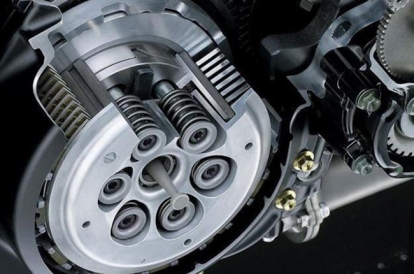Slipper clutches have revolutionised motorcycle dynamics, enhancing control and reducing wear during rapid downshifting. This pivotal development underscores the importance of rider safety and financial considerations in two-wheeler ownership. One such facet that intertwines with these considerations is the realm of two-wheeler insurance policies.
A slipper clutch, or back-torque limiter, minimises the impact of rapid downshifting on motorcycles by allowing controlled slippage between clutch plates. This enhances control and prevents rear wheel lockup during aggressive downshifting.
Operational Mechanism:
During engine braking, conventional clutches cause the rear wheel to slow down abruptly, leading to skids and loss of traction. In contrast, a slipper clutch reduces this impact. As the rear wheel slows down, controlled slippage occurs between the clutch plates, avoiding wheel lockup by decreasing torque.
Components Of A Slipper Clutch:
The clutch assembly consists of essential components: the pressure plate, attached to the clutch cable, engages the clutch, and the clutch hub, fixed to the crankshaft, transfers power to the rear wheel through the clutch plates. Springs maintain plate pressure and facilitate engagement.
Types Of Slipper Clutches:
Slipper clutches exist in mechanical, hydraulic, and electromagnetic types. Mechanical clutches employ a ramp and ball system, hydraulic clutches use a piston to regulate plate pressure, and electromagnetic clutches utilise a coil to control the magnetic field, allowing controlled slippage.
Advantages Of Slipper Clutches:
- Enhanced Control: Enables riders to maintain better control during rapid downshifts, preventing rear wheel lockup and skidding.
- Reduced Wear And Tear: Controlled slippage reduces strain on the gearbox, minimising overall wear and tear on the motorcycle.
- Smooth Ride: Provides smoother gear shifts, enhancing the riding experience and reducing rider fatigue.
- Faster Lap Times: Facilitates later braking and higher speed maintenance through corners, contributing to quicker lap times for racers.
Drawbacks Of Slipper Clutches:
- Cost Increase: Slipper clutches are more expensive than standard clutches as they are more intricate and require additional parts.
- Extra Weight: The added weight may affect the bike’s responsiveness and handling.
- Decreased Engine Braking: Some riders may prefer the traditional engine braking and clutch system.
- Maintenance Requirements: Regular maintenance, including cleaning, lubrication, and inspection, is necessary for optimal performance.
Installation And Maintenance:
Installation involves disassembling the clutch assembly, placing the slipper clutch, and reassembling using recommended tools and lubricants. Regular maintenance, including inspection and replacement of worn components, ensures longevity and peak performance.
Motorcycle slipper clutches reveal an advanced engineering narrative, enhancing the riding experience. The symbiosis between innovation and rider control is evident in the benefits of controlled slippage and smoother gear transitions. Moreover, safeguarding against unforeseen events cannot be overstated in the broader context of two-wheeler ownership with the help of two-wheeler insurance policies.
When opting for a two-wheeler insurance policy, individuals may choose the option of third-party two-wheeler insurance, providing financial protection against liabilities arising from damages or injuries caused to a third party due to the insured’s motorcycle. Always ensure that you carry out the process of two-wheeler insurance renewal on time. Claims are subject to terms and conditions set forth under the motor insurance policy. *
Understanding slipper clutches involves appreciating their mechanical prowess and integrating them into a holistic motorcycle ownership approach. This includes a seamless blend of innovation, control, and financial prudence through comprehensive two-wheeler insurance.
*Standard T&C Apply
Disclaimer: The content on this page is generic and shared only for informational and explanatory purposes. It is based on several secondary sources on the internet and is subject to changes. Please consult an expert before making any related decisions.
Insurance is the subject matter of solicitation. For more details on benefits, exclusions, limitations, terms, and conditions, please read the sales brochure/policy wording carefully before concluding a sale.




